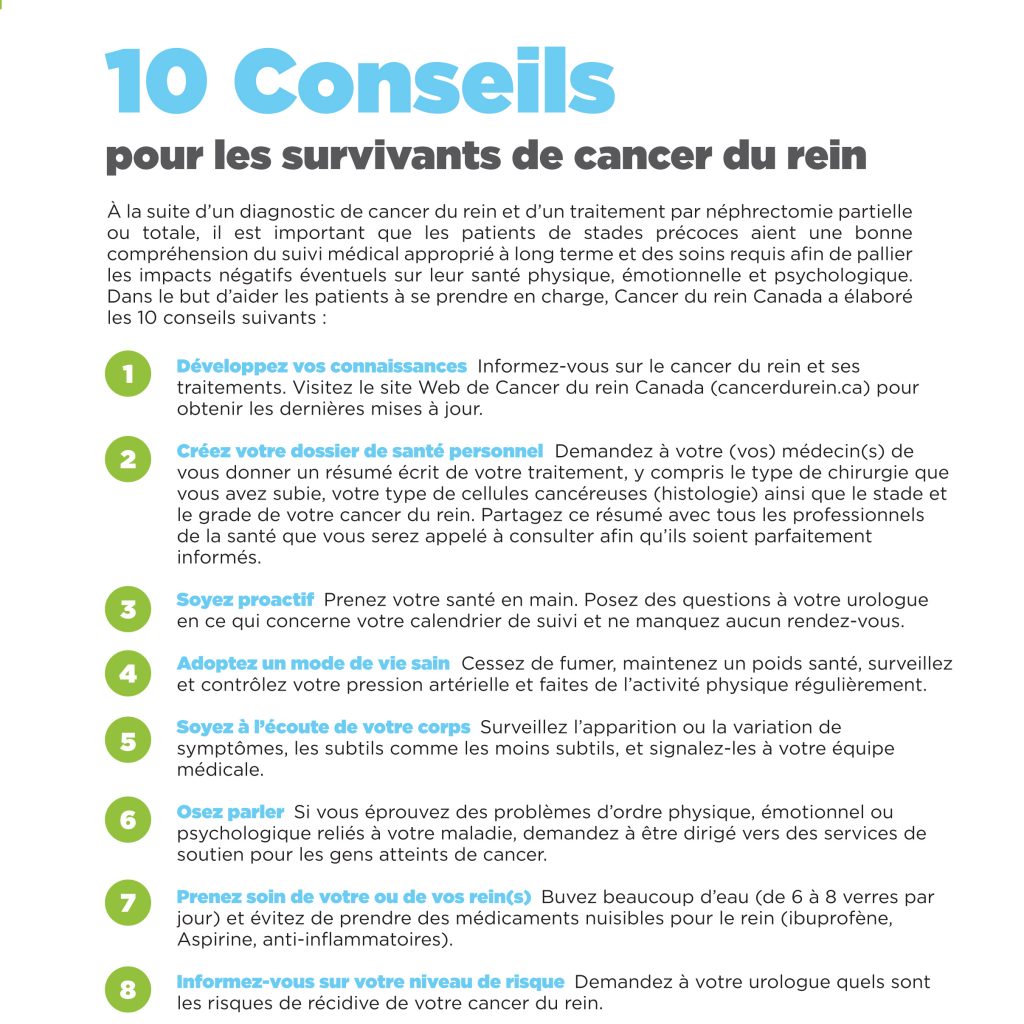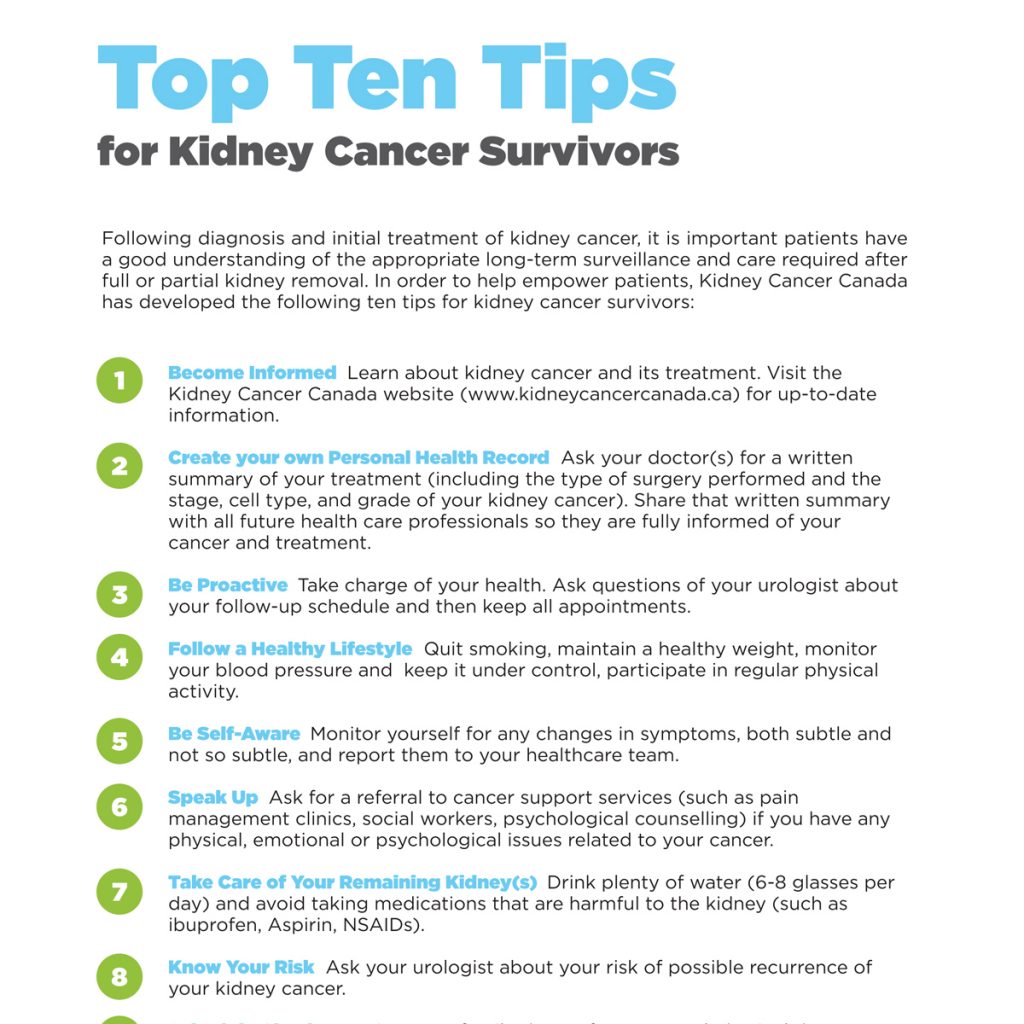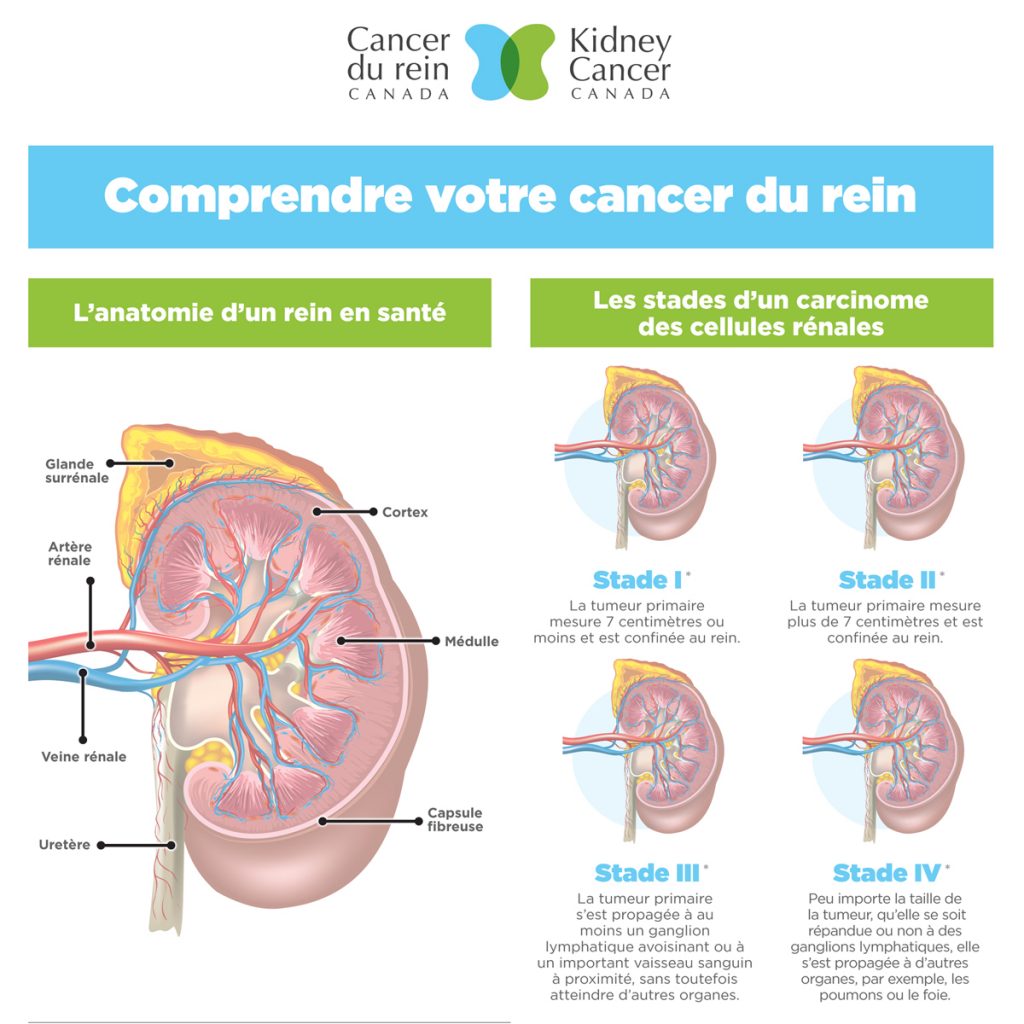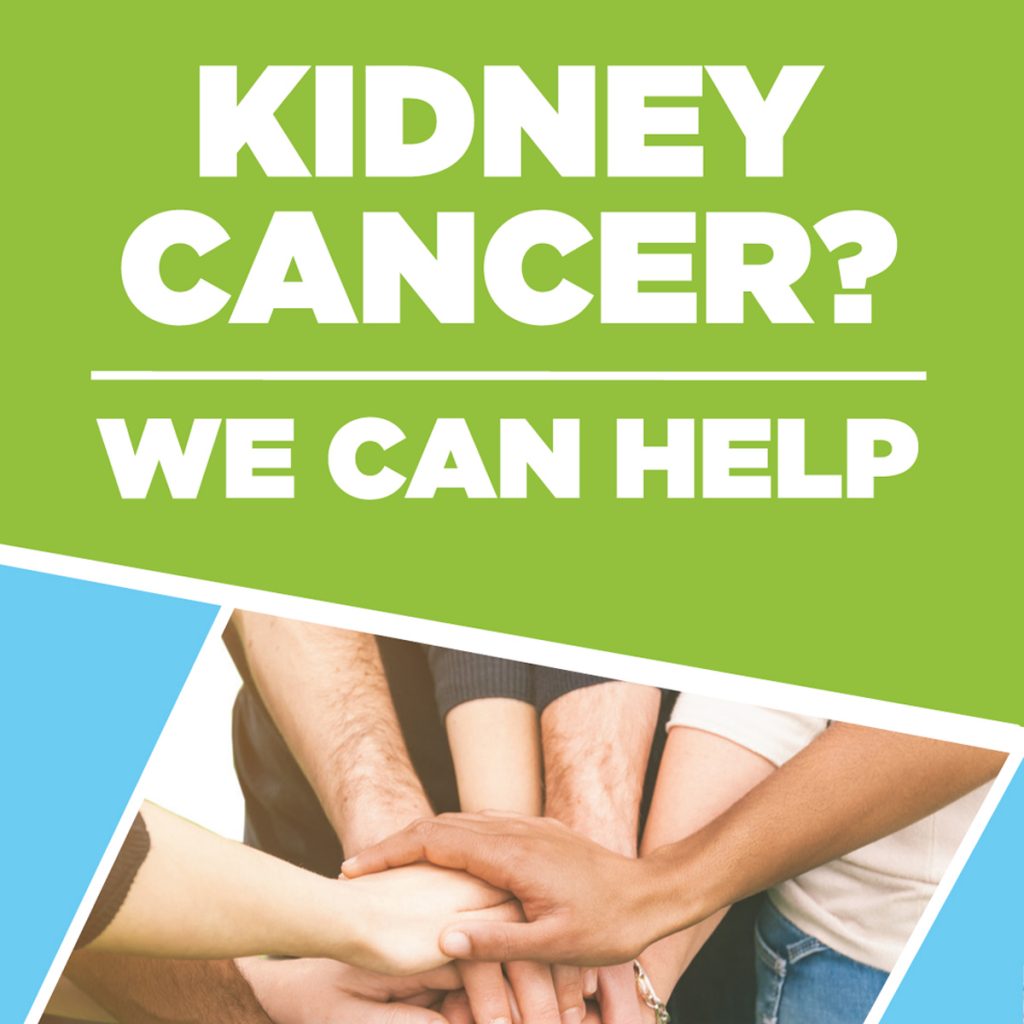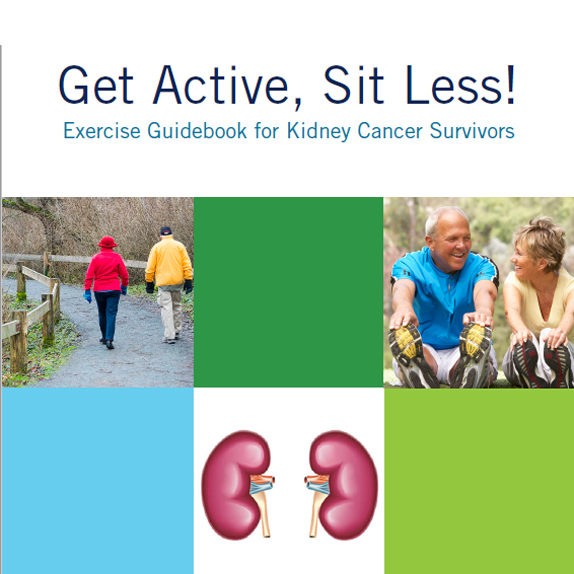We have put together a list of some of the possible side effects of your oral treatment for kidney cancer and strategies that you, as a patient, may try to help you manage these side effects.
Click here for side effects of immuno-oncology therapy
These strategies are suggestions only. Not all of them will work for everyone. Try a different approach if you find that one approach is not working for you. Always remember that your oncologist and oncology nurse are your best resources.
Notify your oncologist or nurse as soon as you first notice any side effects from the treatment. Often early intervention to manage the side effects will decrease the severity of them and allow your doctor to keep you on the full dose of your treatment without any interruptions.
Overall tips
- Prior to starting your treatment, have a thorough dental exam and complete any dental work that is deemed necessary by your dentist.
- Prior to starting your treatment, consider putting together a self-care kit with some or all of the following items:
- Sport drinks (Gatorade®, Powerade®)
- Water- or aloe-based lip balm
- Creams for hands and feet (Aveeno®, Bag Balm®, Lubriderm®, Udder Cream®)
- Cetaphil® cleansing bars (mild, soap-free product)
- Body lotion (Aquafor®, Aveeno®, Curel®, Eucerin®)
- Fragrance-free shower gel
- Soft-bristle toothbrush
- Keep a side effect journal and take it with you to all of your medical appointments. In it record the following:
In the following list are the side effects of treatment that you may experience. You may not experience these side effects, and if you do, the side effects may range from the very mild to the most severe.
WHAT TO DO
- Different foods may trigger diarrhea for different people. Take note of when you experience diarrhea and the foods that may be triggering it for you and report this to your nurse or doctor
- Drink plenty of fluids, 6-8 glasses per day (except at meals) but only in small amounts at any one time; sip fluids slowly.
- You may want to try soy beverages or milk substitutes instead of milk
- You may try “sport” drinks (e.g. Gatorade®, Powerade®) or broths
- Eat often (5-6 times per day) but in small amounts only
- try to eat every 2-3 hours
- eat food at room temperature
- Try a low fat, low fibre, low dairy diet (chicken, fish, white rice, cooked fruits and vegetables, applesauce and toast)
- The consumption of applesauce, bananas, rice, oatmeal, potatoes and carrots may help to increase the consistency of the stools. Consider using the BRAT diet – Bananas, Rice, Applesauce and dry Toast
- Watch your overall food intake to ensure that you are getting adequate nutrition and maintaining your weight
- Nutmeg added to foods may slow down the movement of food material through the intestines
- Use bulking agents (e.g. Benefiber®, Metamucil®) to increase stool consistency
- Use sitz baths, tucks and haemorrhoid barrier creams as needed for comfort
- Cleanse the area around your anus with warm water (with or without a mild soap) or use baby wipes after each bowel movement; pat dry, do not rub
- Discuss the use of loperamide (Imodium) with your doctor (some patients find that the use of loperamide 30 minutes prior to meals helps to reduce diarrhea
WHAT TO AVOID
- Avoid drinking fluids with meals and for 1 hour after all meals
- Avoid spicy foods, fatty foods, sugary foods, dairy products, and high fibre foods
- Avoid caffeinated beverages, alcohol and tobacco
- Avoid very hot or cold foods or fluids
- Avoid milk and dairy products
- Avoid orange and prune juices (reminder: you should be avoiding grapefruit juice at all times)
- Avoid eating raw vegetables
- Avoid skin, seeds and membranes from fruits and vegetables
- Limit corn, broccoli, beans, peas, green leafy vegetables, prunes, berries, dried fruit, legumes, lentils
- Avoid prunes, rhubarb and papaya
- Avoid sugar-free gum and candies containing sorbitol (sorbitol acts like a laxative)
POSSIBLE DOCTOR STRATEGIES
- May prescribe loperamide (Imodium), diphenoxylate (Lomotil) or cholestyramine
WHAT TO DO
- Use antacids
- Eat products containing acidophilus bacteria (e.g. some yogurts, some cheeses)
WHAT TO AVOID
- Avoid eating gas-producing foods (e.g. beans, legumes, bulky vegetables)
- Avoid drinking carbonated beverages
POSSIBLE DOCTOR STRATEGIES
- May prescribe medications to aid in the motility of your digestive system
WHAT TO DO
- Use scarves, wigs/hairpieces, hats
- If you have a private drug plan, it may cover the cost of a wig
- Wear hats in cold weather to prevent heat loss from your scalp
- Inspect your scalp for rashes, sunburn, scratches or blisters
- Use a satin pillowcase
- Brush hair gently
- Use a neutral pH shampoo
WHAT TO AVOID
- Avoid sun exposure
- Avoid high heat on hair dryers
- Avoid curling irons and hair straighteners
- Avoid hair dyes and permanents
- Do not braid your hair
WHAT TO DO
- Use a straw for drinking to get the fluids to the back of your mouth
- Use bottled drinks instead of cans
- Use plastic knives, forks and spoons and glass cups and plates
- Use fresh or frozen fruits and vegetables
- Season your foods with tart flavours
- Use new spices, herbs, sugar, lemon or condiments to flavour foods
- Cold or frozen foods may taste better than hot foods
- Try marinating meats (eg. fruit juices, sweet wines, salad dressings, bottled marinades)
- Room temperature or cold foods may be easier to tolerate
- Switch up your foods. If one food’s taste is not appealing, try substituting another (e.g. chicken for beef)
- Have someone else prepare your food to limit exposure to food odours
- Before meals, rinse your mouth with ginger ale
- Try brushing your teeth before meals too
- Rinse your mouth with a weak solution of salt and baking soda (½ teaspoon of salt + ½ teaspoon of baking soda in 1 cup of water) before meals
- Brush your teeth often to keep your mouth clean
- Sucking on lemon candies may help with a metallic taste
- Suck on candies or mints
- Chew mint gum
WHAT TO AVOID
- Avoid canned fruits and vegetables
- Avoid mint-flavoured toothpastes
- Avoid hot foods
- Avoid smoking
- Avoid canned drinks
- Stay away from food odours
WHAT TO DO
- Brush your teeth gently after eating and at bedtime with a very soft toothbrush
- An infant toothbrush may be used
- Place your toothbrush under hot running water to soften the bristles before using
- Floss your teeth gently
- Use non-abrasive toothpastes (children’s toothpastes, Sensodyne® toothpastes)
- Use Biotene® products
- Clean dentures every day
- Remove dentures at night and frequently throughout the day
- Rinse your mouth often (swish, gargle & spit) with a weak solution of salt and baking soda (½ teaspoon of salt + ½ teaspoon of baking soda in 1 cup of water); good times to do this are before and after meals and at bedtime
- Use baking soda instead of toothpaste if your gums are bleeding
- Use a straw for drinking
- Eat foods that require little or no chewing
- Eat foods that are lukewarm or cold
- Eat foods that are soft and creamy such as yogurt, pudding, ice cream
- Take sips of water or other liquids while eating to keep your mouth moist
- When eating and drinking, tilt your head back to help get the food and fluids to the back of your throat for easier swallowing
- Sit upright when eating or drinking
- Use a blender to puree foods
- Moisten dry foods with broth, sauces, milk or butter/margerine
- Eat small frequent meals – whenever you are hungry
- Choose foods that are high in calories and protein
- Sucking on ice chips, frozen fruit pops may help
- Drink 8-12 cups of fluid per day
- Suck on candy or chews gum to keep mouth moist
- Keep lips moist with a water- or aloe-based lip balm
WHAT TO AVOID
- Avoid alcohol-based mouthwashes
- Avoid toothpastes with whiteners
- Limit use of dental floss
- Do not wear your dentures if you have severe mouth sores
- Avoid alcohol, caffeine and smoking
- Avoid citrus, acidic or carbonated drinks
- Avoid foods that are acidic, salty, spicy or dry
- Avoid very hot foods
- Avoid very crisp, rough, hard foods (e.g. crackers, potato chips, tortilla chips, pretzels, raw vegetables, dry toast)
- Do not use Vaseline® or other petroleum-based products for lip moisturization
POSSIBLE DOCTOR STRATEGIES
- May prescribe Orabase® or Gelclair®
- May prescribe BMX solution (solution with benadryl, Maalox & xylocaine)
- May prescribe topical lidocaine or Magic mouthwash
- May prescribe fluconazole (Diflucan) or clotrimazole (Canesten) if fungal infection is also present
WHAT TO DO
- Conserve your energy by setting priorities, pacing your activities and delegating as much as possible to family and friends
- Take advantage of your good days to do the activities that absolutely must be done or that give you pleasure and a sense of accomplishment
- Take rest periods throughout the day
- Short naps (30 -45 minutes) may help as long as they do not interfere with your night time sleep
- Try to keep your normal sleep routine
- Use relaxation techniques, massage, yoga, meditation to manage stress
- Try to maintain your normal work and social schedules whenever possible
- Re-energize with activities that you enjoy doing
- Stay as active as possible for you – activity throughout the day allows for better sleep at night
- Increase your physical activity gradually; take short walks or do light exercise
- Plan your exercise for times when your energy levels are at their highest point
- Talk with your employer about your level of fatigue and possible scheduling adjustments that you may need to make
- Plan activities that require concentration when most rested
- Let family and friends know that you may have to cancel planned activities if you are experiencing extreme fatigue
- Limit visitors and ask them to call first to schedule their visit time
WHAT TO AVOID
- Avoid caffeine
- Avoid driving a car or operating heavy machinery when feeling tired
- Avoid long naps during the daytime
- Avoid caffeinated beverages, smoking or alcohol before bedtime
- Do not engage in strenuous activities before bedtime
POSSIBLE DOCTOR STRATEGIES
- May perform tests to rule out thyroid problems or anemia
- May try reducing your dose, delaying the start of your next cycle or a change in the treatment schedule
MILD TO MODERATE
- Redness
- SwellingTingling or burning sensation
- Numbness
- Tenderness
- Rash
SEVERE
- Cracked, flaking or peeling skin
- Blisters, ulcers or sores
- Severe pain
- Causing difficulties walking or using your hands
WHAT TO DO
- Strongly consider having a manicure and pedicure at a reputable salon prior to the start of treatment to aid in the moisturization of your hands and feet and to remove any calluses
- Continue to have manicures and pedicures or visits with a podiatrist throughout treatment
- Reduce the exposure of hands and feet to hot water
- Take cool baths or showers
- Carefully pat your skin dry
- Use padded insoles or gel pads in footwear
- Try to wear loose footwear with ventilation (such as sandals)
- Wear loose-fitting slippers around the house
- Use cotton gloves and socks to keep the hands protected
- Frequently and liberally apply fragrance-free creams containing lanolin or urea (5-10%) to the hands and feet, especially in all creases, throughout the day
- Suggestions for creams are Bag Balm®, Udder Cream®, Aveeno® or Lubriderm®
- Apply the creams gently
- Apply creams liberally to your hands and feet at bedtime and wear a loose pair of gloves and socks while sleeping
- Apply cool compresses or ice packs to your hands or feet. Apply only for 15 to 20 minutes at a time and cover the ice pack with a towel before applying. A bag of frozen corn or peas works well as it conforms to the shape of your hands or feet
- Soak hands and/or feet in basins of cold water for 15 minutes at a time, 3 to 4 times per day
- Elevate your hands and feet frequently throughout the day
- Talk with your doctor before using any new vitamins or medications
WHAT TO AVOID
- Avoid the use of rubber gloves
- Avoid rubbing as this causes friction to the skin surfaces
- Avoid exposure to heat sources such as sun, saunas
- Avoid hot showers or baths
- Avoid any contact with harsh chemicals including laundry detergents and cleaning products
- Avoid creams and lotions with perfumes, alcohol or glycerin
- Avoid constrictive footwear
- Avoid tight-fitting socks or stockings
- Avoid wearing tight-fitting jewellery
- Avoid activities or exercises that put stress on the hands and feet such as jogging, long walks
- Avoid the use of tools that require you to grip them firmly in your hand (eg. knives, garden tools, screwdrivers, hammers)
- Avoid breaking any blisters if they form as they may become infected
POSSIBLE DOCTOR STRATEGIES
- Oral or topical corticosteroids
- Pain medications
- Delay treatment
- Adjust dosage or schedule of treatment
WHAT TO DO
- Use sun protection whenever outside (SPF of at least 30) and re-apply every 2 hours or more. The sunscreen should contain titanium dioxide or zinc oxide. Use an adequate amount of sunscreen
- Use a broad-brimmed hat when outside
- Wear loose-fitting cotton clothing
- Use a mild, fragrance-free soap (eg. Cetaphil®)
- Shower with warm water
- Liberally apply fragrance-free, hypoallergenic, moisturizing skin lotions often, particularly after showering (within 15 minutes) and before bedtime (e.g. Utterly Soft®, Eucerin® or Aveeno®)
- If the skin is very dry, use urea-based lotions
- Anti-dandruff shampoos are helpful for itchy scalps
- Colloidal oatmeal lotion or oatmeal bath (Aveeno®) may be helpful
- Coverage make-up can be safely applied (Cover FX®)
- Use a humidifier and keep your household environment on the cool side
WHAT TO AVOID
- Avoid hot showers
- Avoid sun exposure especially during the peak hours of 11 AM – 3 PM
- Avoid tanning salons
- Avoid scratching
- Do not squeeze pimples
- Avoid anti-acne products
- Avoid use of anti-bacterial soaps
- Avoid alcohol-based, fragranced products
- Avoid products with alcohol, benzoyl peroxide, retinoids or salicylic acid
- Avoid shaving in affected area
- Avoid chlorinated pools, hot tubs
- Avoid laundry detergents with strong perfumes
POSSIBLE DOCTOR STRATEGIES
- Topical medicated creams such as Elidel, tacrolimus, clindamycin gels or corticosteroids
- Tetracycline antibiotics
- Prednisone
- May suggest camphor-based creams for dry, itching skin
- May prescribe antihistamines if itching is a significant problem
WHAT TO DO
- Wash with warm water
- Use liquid shower gels, preferably fragrance-free
- Use a mild face cleanser (e.g. Cetaphil®)
- Apply skin cream/lotion liberally immediately after baths or showers
- Use lotions with anti-itch formulations (Aveeno®, Udderly Smooth®, Gold Bond®)
- Use creams or lotions with aloe vera or dimethicone (Curel®, Aveeno®, Eucerin®, Aquafor®)
- Use anti-dandruff shampoos and conditioners
- Use an anti-dandruff shampoo as a body wash for itchy skin
- Use a non-allergenic deodorant if you become sensitive to your normal deodorant
- Use an electric razor for shaving
- Use sunscreen with an SPF of 30 or higher
- Protect your skin from extreme heat or cold
- Wear gloves during cold weather
- Drink 8-10 glasses of fluids per day
WHAT TO AVOID
- Avoid products with deodorants or fragrance
- Avoid hot water for bathing and showers
- Avoid using straight-blade razors for shaving
- Avoid irritating clothing fabrics (e.g. wool)
POSSIBLE DOCTOR STRATEGIES
- May prescribe methylprednisolone
WHAT TO DO
- Use a cuticle cream nightly
- Wear rubber gloves when doing housework
- Moisturize your hands
- Keep nails cut short
- Soak your nails in oil (e.g. vegetable or olive oil)
- Massage vegetable or olive oil into your nails daily; alternatively, use tea tree oils or Bag Balm®
- Keep nails clean and protected if they break or lift off
- Report any signs of nail infection (redness, swelling, warmth) to your oncologist or nurse immediately
WHAT TO AVOID
- Avoid cutting your cuticles
WHAT TO DO
- Eat light meals, 5 to 6 per day
- Choose foods with the most calories per serving
- Try to eat a few mouthfuls even if you do not feel hungry at the time
- Drink high calorie beverages (fruit juices, milk, hot chocolate, shakes, smoothies, instant breakfast drinks, Ovaltine®) between meals
- Consider using commercial nutritional beverages such as Boost® or Ensure®
- Use gravies, sauces, butter, cheese, cream as additions to your food to increase the calories
- Choose high calorie snack foods (such as peanut butter, cheese, ice cream, puddings, yogurt, cottage cheese, eggs, nuts, trail mixes, cereal, granola bars)
- Eat snacks frequently throughout the day
- Keep snacks with you at all times to nibble on
- Keep your favourite foods nearby for snacking
- Try different foods and drinks. Sometimes new foods may have more appeal
- Focus on the meal when your appetite is at its best and make it the main meal of the day
- Eat soft, high-caloric foods
- Eat the most nutritious foods first
- Try to engage in some physical activity before meals
- Eat your meals with family and friends
- Ask for help from family and friends to prepare your meals and shop for groceries
- Eat foods cold or at room temperature to control odours and reduce tastes
- Drink fluids at least 30-60 minutes before or after a meal
- Consider the use of complementary approaches (eg. aromatherapy, massage therapy, meditation, music therapy)
- Take any required pain medications at least 30-60 minutes prior to your meal
- Create pleasant settings for your meals including music
WHAT TO AVOID
- Avoid low fat foods
- Avoid diet foods
- Avoid spicy and fried foods
- Avoid the sight or smell of food
- Limit your fluid intake at meal times
- Avoid empty calorie foods
- Avoid tobacco products
POSSIBLE DOCTOR STRATEGIES
- May prescribe Megestrol acetate (Megace), steroid medications, or metoclopramide (Maxeran)
WHAT TO DO
- Increase your intake of warm or hot fluids, especially in the morning
- Maintain a fluid intake of at least eight, 8-oz servings (consumption of caffeinated beverages should not be included in this amount)
- Increase your consumption of dietary fibre including whole grains and fruits/vegetables
- Choose foods that are natural laxatives (eg. prunes, papayas, rhubarb)
- Try to be more active with some daily exercise
- Maintain a regular daily schedule for bowel movements, preferably after breakfast
- Talk with your healthcare team before starting over-the-counter laxatives, stool softeners or enemas
WHAT TO AVOID
- Avoid chocolate, cheese, eggs, beef or fatty fried foods
POSSIBLE DOCTOR STRATEGIES
- May prescribe the use of a stool softener (docusate sodium, known as Colace) and a laxative (sennosides, known as Senokot)
WHAT TO DO
- Use a forward-leaning position
- Use a pursed-lip breathing technique
- Consider relaxation training or meditation
- Try to keep yourself distracted
- Keep your head lifted on extra pillows when in bed
- Prioritize your activities to conserve energy
- Sit in front of a circulating fan
- Lower room temperatures slightly
- Open a nearby window
- Use a cool-air vaporizer or humidifier too keep room air moist
- If you experience sudden or significant shortness of breath (i.e. a significant change from your usual symptoms), please get urgent medical attention
- A cough with Torisel (temsirolimus) or Afinitor (everolimus) may be the first sign of a serious medical problem. Your doctor needs to know about this immediately
WHAT TO AVOID
- Avoid smoke-filled areas
- Avoid pet dander
- Avoid going outside on hot, humid days or extremely cold days
- Avoid tight-fitting clothing especially around your neck and chest
POSSIBLE DOCTOR STRATEGIES
- May prescribe cough suppressants
WHAT TO DO
- Visit your dentist at least two weeks before beginning treatment
- Perform good oral hygiene at least four times a day (after each meal and at bedtime)
- Use a soft-bristle brush soaked in warm water
- Use a fluoride toothpaste
- Rinse your mouth and wipe your lips immediately after every meal
- Rinse and brush your dentures after every meal
- Keep the mouth moist with frequent sips of water
- Keep water at your bedside and take sips throughout the night
- Suck on ice chips
- Use a salt and baking soda rinse 4-6 times a day (½ tsp. salt, ½ tsp. of baking soda dissolved in 8 oz. of water)
- Frequently apply a lip balm that is lanolin or aloe-based
- Use artificial saliva or salivary substitutes
- Chew gum or suck on candies
- Use a cool-mist humidifier, especially at night
- Drink at least 8 glasses of water a day. Keep water with you at all times
- Eat soft, moist foods that are cool or at room temperature
- Moisten dry foods with gravies, sauces, broth or milk
WHAT TO AVOID
- Avoid beverages with a high sugar content (soda pop, fruit juices)
- Avoid alcohol, caffeinated beverages, acidic fruit juices
- Avoid alcohol-containing mouth washes
- Avoid tobacco
- Avoid acidic or spicy foods
- Avoid dry, coarse or hard foods
POSSIBLE DOCTOR STRATEGIES
- May prescribe pilocarpine
WHAT TO DO
- Ensure that you are getting an adequate amount of sleep
- Eat a nutritious, well-planned diet
- Use complementary therapies such as massage, acupuncture, visual imagery, relaxation techniques, yoga, meditation to reduce your stress levels
- Ask your healthcare team about the use of over-the-counter pain relievers
- May be caused by an increase in blood pressure and so you should monitor your blood pressure and report any changes to your doctor or nurse
WHAT TO AVOID
- Avoid bright lights
- Avoid loud sounds
POSSIBLE DOCTOR STRATEGIES
- May prescribe non-narcotic or narcotic pain relievers
WHAT TO DO
- Establish a regular time for going to bed each night and a regular time for getting up each morning
- Establish pre-bedtime rituals
- Take a warm bath, read or listen to music within two hours of your bedtime
- Drink a warm glass of milk or chamomile tea before bedtime
- Use relaxation techniques such as massage, yoga, meditation
- If unable to sleep, get out of bed and go to another room
- Use your bed for sleep and sexual activities only
- Keep your bedroom dark, quiet, cool and comfortable
- Limit daytime naps to 30-45 minutes
- Have dinner 3 hours before bedtime
- Complete any physical exercise at least three hours prior to bedtime
- Discuss the use of any herbal product or over-the-counter sleep aids with your healthcare team prior to use
WHAT TO AVOID
- Avoid daytime napping if possible
- Do not nap after 3 pm
- Avoid caffeine after noon
- Do not go to bed hungry
- Avoid watching TV in the bedroom
- Avoid alcohol for 4-6 hours before bedtime
- Avoid tobacco, especially at night
- Avoid heavy or spicy meals before bedtime
- Avoid clock-watching throughout the night
- Avoid drinking too many fluids in the evening hours
POSSIBLE DOCTOR STRATEGIES
- May prescribe hypnotic medications (sleeping pills)
WHAT TO DO
- Drink 6-8 glasses of fluid per day
- Recommended fluids are broth, Gatorade®, Jello®, fruit juices, Popsicles®, soda, gingerale, peppermint tea, ginger tea, weak tea with honey
- Allow carbonated beverages to go flat prior to drinking
- Sip liquids slowly
- Cool liquids may be easier to drink than hot or cold ones
- Eat dry, bland foods such as crackers, toast, dry cereal, pretzels, bread sticks, ginger cookies
- Eat small, frequent meals (5-6 per day)
- Nibble on crystallized ginger
- Sit up for 1-2 hours after each meal
- Wear loose clothing
- Place a cold cloth on your forehead
- Rinse your mouth throughout the day, especially before and after eating, with a solution of ¼ tsp. of baking soda diluted in 8 oz. of water
- Consider acupuncture, acupressure, guided imagery, music therapy and muscle relaxation techniques
- Ask family and friends to prepare your meals
- Suck on mints or hard candies throughout the day
- Keep your mouth clean; brushing at least 2 times per day
- Take slow, deep breaths through your mouth during times of nausea
- Distract yourself with TV, radio, games, music
WHAT TO AVOID
- Avoid alcohol and caffeinated beverages
- Avoid fatty, fried, or spicy foods
- Avoid sweet desserts
- Avoid acidic fruit juices and tomatoes
- Avoid drinking fluids at the same time as your meals
- Avoid making sudden movements
- Avoid unpleasant or strong odours
- Avoid combining hot and cold foods at the same meal
- Avoid eating your favourite foods at this time as you may then dislike them later
- Avoid eating in a warm, stuffy environment
POSSIBLE DOCTOR STRATEGIES
- May prescribe antiemetic medications (drugs to stop vomiting)
- May try reducing your dose, delaying the start of your next cycle or a change in the treatment schedule
WHAT TO DO
- Reduce the amount of salt in your diet
- Elevate the affected area when sitting or lying down
- Walk or increase your activity to help pump fluids back into your circulation
WHAT TO AVOID
- Avoid standing for long periods of time
- Do not sit with your legs crossed
POSSIBLE DOCTOR STRATEGIES
- May prescribe diuretics
- May recommend the use of compression stockings








































